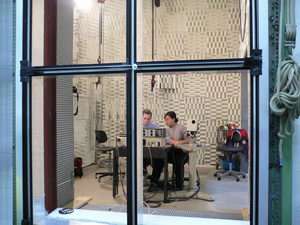Noise-absorbing windows

The noise of aircraft taking off, road traffic or a booming discotheque often drive inhabitants of the neighborhood to a nervous frenzy. The first-ever windows with active sound insulation offer much-needed relief to local residents in their homes and offices.
When an aircraft takes off over your roof every five minutes, the noise makes it impossible to hold a conversation. Windows can’t provide adequate protection against this type of noise pollution.
A double or triple layer of glass will absorb the high frequencies, but can do nothing against low-frequency noise such as that produced by aircrafts or thrumming bass tones of disco music. This would normally call for panes of glass so thick and heavy that their use would be almost prohibitive in lightweight constructions or extensive curtain-wall facades.
Researchers at the Fraunhofer Institute for Structural Durability and System Reliability LBF and Darmstadt University of Technology have found a solution, namely a new type of soundproof window. “Tests have shown that our windows are capable of lowering noise levels by an average of six decibels at frequencies between 50 and 1000 hertz. The perceived noise indoors is only half as loud,” says Dr. Thilo Bein, who manages the institute’s department of energy, environment and health. “We have even been able to reduce the volume of certain test signals by up to 15 decibels.” The experts have predicted a reduction of up to 10 dB for the engine noise of passenger aircraft in the frequency range below 1000 Hz.
When noise waves meet the walls of a building, they can be propagated to the interior by various routes. One is by causing the windows to vibrate, thus carrying the noise into the building. The other is by transmitting sound waves to the interior via the bridges in the structure where the curtain-wall elements are attached to the frame of the building. In both cases, the researchers have found a way to prevent the propagation of sound energy. Acceleration sensors attached to the window panes measure the vibrations generated by the noise.
A thin chip of piezoelectric material also attached to the window counteracts the vibration by generating an oscillation at the same pitch but in the opposite sense to that measured by the sensor – causing the pane to move in the opposing direction. “We have devised a similar solution for the points where the outer cladding is attached to the frame of the building. In this case, a stack of piezoelectric chips, rather than a single piezoelectric strip, counteracts the impinging force,” says Bein.
The researchers will be presenting a prototype of the new soundproof window at the Hannover Fair from April 16 to 20. According to Bein’s estimations, the new active noise-reducing windows could be on the market in about four years’ time.
Source: Fraunhofer-Gesellschaft





















